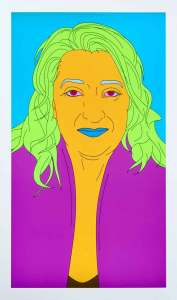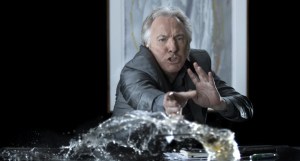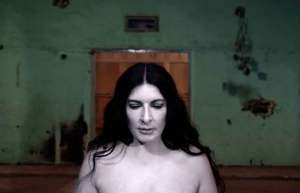In the best of ways, digital portraiture is posing some problems. Challenging the notion and definition of an art form that is still closely associated with painting or still photography, digital media is evolving the face of portraiture.

Dame Zaha Hadid (2008), Michael Craig-Martin © National Portrait Gallery, London
‘At present, as so many of us filter our own lives and identity through the prism of social media, the digital or computer-generated portrait has never been more relevant,’ says Rosie Broadley, Associate Curator at London’s National Portrait Gallery, where digital commissions have included a representation of architect Zaha Hadid by Michael Craig-Martin in which algorithms generate changes in the image, and Sam Taylor-Wood’s 2004 film of David Beckham.
Last year, British artist Kyle Lambert caused a viral stir, with a portrait of Morgan Freeman created entirely by fingertip: on an iPad, with 285,000 brushstrokes over 200 hours. A video that charted the making of the portrait inspired exclamations of awe from numerous media outlets, as well as questions about the authenticity of Lambert’s work or whether it could be classed as photorealistic ‘cheating’. Is the fact that this level of true-to-life detail can be achieved on a tablet – still by hand, but requiring mastery of computer effects instead of the ability to mix shades of paint – less impressive than an identical portrait created with a brush? Is the eye of the artist more praiseworthy upon the creation of a tangible, rather than digital, masterpiece?
In a chapter on the 20th century, James Hall, author of the forthcoming tome The Self-Portrait: A Cultural History, discusses the face being upstaged in recent decades by the body. ‘Once portraitists and self-portraitists start to include more of the body and de-throne the face, it becomes, in a strange way, more anonymous’, he argues.

Portraits in Dramatic Time: Alan Rickman (2011), David Michalek www.davidmichalek.net
Video portraiture, however, offers a particularly convincing rebuttal. American artist David Michalek, for instance, directs the manipulation of time, creating intensely personal video tableaux that might be 10 minutes or an hour long. His sitters – or perhaps more appropriately, movers – have ranged from esteemed ballet dancers to Alan Rickman, the subject of a dramatic 8-minute scene created using ultra high-speed HD cameras, filmed over 10 to 15 seconds. His work has been shown in Trafalgar Square, but Michalek also assembles stages and scripts for private clients. For collectors facing a digital dilemma, artists who work to commission present a key opportunity.
‘It is no news that we are growing more and more disconnected from each other on a face to face basis,’ says Matthu Placek, whose work explores technology and how its advancement affects human interactions. Employing both one-take cinematography and 3D cinematography in works such as 130919 • A Portrait of Marina Abramovic, Placek sees his methods as ‘the closest possible way I can imagine to introduce a person to a viewer. The subject is tangible, confrontational, exposed and vulnerable.’

130919 • A Portrait of Marina Abramović (video still; 2013), Matthu Placek
For such works, curatorial challenges range from figuring out how to project a video file onto an appropriately sized and placed screen, to anticipating how display components will become outdated as technology develops.
‘It’s not just the eyes following you round a room, it’s actually the whole body literally following you round the room,’ describes Hall. But can these stirring new art forms and their ability to interact, move and transform pose any threat to the kingpin, painting?
‘It may be that the proliferation of images in the media, particularly online, gives painting and sculpture the opportunity to represent something different, beyond rather than in the wake of new technology,’ suggests Broadley. ‘All portraits, including digital, are an artist’s interpretation of a sitter, but a painting will always be imbued with so much of artist’s own energy that it is never simply a likeness, and always entirely unique.’

Moving On
Dame Zaha Hadid (detail; 2008), Michael Craig-Martin © National Portrait Gallery, London; commissioned by the National Portrait Gallery with the support of J.P. Morgan through the Fund for New Commissions
Share
In the best of ways, digital portraiture is posing some problems. Challenging the notion and definition of an art form that is still closely associated with painting or still photography, digital media is evolving the face of portraiture.
Dame Zaha Hadid (2008), Michael Craig-Martin © National Portrait Gallery, London
‘At present, as so many of us filter our own lives and identity through the prism of social media, the digital or computer-generated portrait has never been more relevant,’ says Rosie Broadley, Associate Curator at London’s National Portrait Gallery, where digital commissions have included a representation of architect Zaha Hadid by Michael Craig-Martin in which algorithms generate changes in the image, and Sam Taylor-Wood’s 2004 film of David Beckham.
Last year, British artist Kyle Lambert caused a viral stir, with a portrait of Morgan Freeman created entirely by fingertip: on an iPad, with 285,000 brushstrokes over 200 hours. A video that charted the making of the portrait inspired exclamations of awe from numerous media outlets, as well as questions about the authenticity of Lambert’s work or whether it could be classed as photorealistic ‘cheating’. Is the fact that this level of true-to-life detail can be achieved on a tablet – still by hand, but requiring mastery of computer effects instead of the ability to mix shades of paint – less impressive than an identical portrait created with a brush? Is the eye of the artist more praiseworthy upon the creation of a tangible, rather than digital, masterpiece?
In a chapter on the 20th century, James Hall, author of the forthcoming tome The Self-Portrait: A Cultural History, discusses the face being upstaged in recent decades by the body. ‘Once portraitists and self-portraitists start to include more of the body and de-throne the face, it becomes, in a strange way, more anonymous’, he argues.
Portraits in Dramatic Time: Alan Rickman (2011), David Michalek www.davidmichalek.net
Video portraiture, however, offers a particularly convincing rebuttal. American artist David Michalek, for instance, directs the manipulation of time, creating intensely personal video tableaux that might be 10 minutes or an hour long. His sitters – or perhaps more appropriately, movers – have ranged from esteemed ballet dancers to Alan Rickman, the subject of a dramatic 8-minute scene created using ultra high-speed HD cameras, filmed over 10 to 15 seconds. His work has been shown in Trafalgar Square, but Michalek also assembles stages and scripts for private clients. For collectors facing a digital dilemma, artists who work to commission present a key opportunity.
‘It is no news that we are growing more and more disconnected from each other on a face to face basis,’ says Matthu Placek, whose work explores technology and how its advancement affects human interactions. Employing both one-take cinematography and 3D cinematography in works such as 130919 • A Portrait of Marina Abramovic, Placek sees his methods as ‘the closest possible way I can imagine to introduce a person to a viewer. The subject is tangible, confrontational, exposed and vulnerable.’
130919 • A Portrait of Marina Abramović (video still; 2013), Matthu Placek
For such works, curatorial challenges range from figuring out how to project a video file onto an appropriately sized and placed screen, to anticipating how display components will become outdated as technology develops.
‘It’s not just the eyes following you round a room, it’s actually the whole body literally following you round the room,’ describes Hall. But can these stirring new art forms and their ability to interact, move and transform pose any threat to the kingpin, painting?
‘It may be that the proliferation of images in the media, particularly online, gives painting and sculpture the opportunity to represent something different, beyond rather than in the wake of new technology,’ suggests Broadley. ‘All portraits, including digital, are an artist’s interpretation of a sitter, but a painting will always be imbued with so much of artist’s own energy that it is never simply a likeness, and always entirely unique.’
Unlimited access from just $16 every 3 months
Subscribe to get unlimited and exclusive access to the top art stories, interviews and exhibition reviews.
Share
Recommended for you
First Look: Joseph Wright of Derby
Amina Wright introduces ‘Joseph Wright of Derby: Bath and Beyond’ at the Holburne Museum
Well Met
Art and archaeology aren’t neat categories at the best of times. At the Metropolitan Museum of Art, they’re allowed to overlap
Broken Engagement
Installation art is assumed to be inherently more engaging than other genres – so why are visitors so often left to watch from the wings?